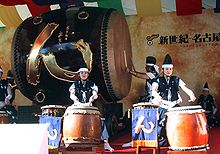Taiko


Taiko ( Japanese 太 鼓 , dt. "Thick drum"; also pronounced daiko in compositions ) denotes in Japan a group of large tubular drums struck with mallets and in the West also the style of playing of the corresponding drum ensemble.
history
The oldest drums in the design of the Taiko come from China . This type of drum came to Korea from there . In the Kofun period (300 BC to 300 AD), the inhabitants of the Korean peninsula and the Japanese archipelago were not yet separated from one another in today's national borders and in the course of the extensive cultural exchange at that time, the taiko also came to the Japanese archipelago. It probably served first in the shamanic rituals of the forerunners of the Shinto religion to conjure up various kami , in particular the storm and life god Susanoo , who also ruled the weather.
Even in China , drums were used more frequently than bells or gongs in temples , and with the import of Buddhism (in the 4th to 6th centuries), its instruments followed to Japan. Here they found their way into the use of simple farmers and fishermen, who used them as an accompaniment for heavy field work, as a signal on the beach or as an alarm signal in the event of raids. Here, too, a colorful use for all kinds of festivities has been passed down to this day.
The samurai recognized the effectiveness of the Taiko and let the big drums play before the attack: this was intended to wear down the opponent mentally on the one hand, and to put one's own fighters in a blood frenzy on the other , which, in shamanic terms, corresponds to an ecstatic obsession, i.e. the god on one's own side The battlefield. In Noh -Theater Shimedaiko be used since the 14th century; from there it was taken over into the other forms of theater.
Nowadays, in addition to religious use, there are also forms of taiko drumming that have been further developed for the stage as art, which are also enjoying increasing popularity outside of Japan and have led to numerous imitators there. The most famous Taiko groups include Ondekoza, Gocoo , Tao, Yamato and Kodō .
Shape and construction
Taiko is used in Japan to refer to barrel-shaped and cylindrical tubular drums, in particular the barrel-shaped miyadaiko ( 宮 太 鼓 , "shrine drum" or nagadō daiko , 長 胴 太 鼓 , "drum with an elongated body" - in contrast) to hiradō daiko 平 胴 太 鼓 "drum with a flat body" (Engl. hiradō taiko drum), the body of which is much shorter than the skin diameter). Depending on the size and shape, Taiko is further differentiated and among other things as sumō daiko ( 相撲 太 鼓 , approx. 25 cm diameter), shimedaiko ( 締 太 鼓 ; small, flat and high-pitched drums tensioned with ropes or screws (tension bolts)), okedō daiko ( 桶 胴 太 鼓 , "vat body drum", portable drums stretched with rope with a body composed of staves like a Japanese vat and therefore light; often used for field work; diameter 25 - 60 cm), miyadaiko or ōdaiko ( 大 太 鼓 ; from 91 cm). The body ( 胴 , dō ) of a traditionally made Taiko is carved out of one piece (that is, a single tree trunk section). Modern inexpensive Taiko have a body that is composed of several segments like a barrel and also glued. Today, the drum blanks are turned on the outside using a lathe, and this is how the round shape of the body is achieved. Originally only the wood of the kejaki tree ( zelkove ) was used to build the drums, but today some wood from other elm plants is also used. The largest nagadō daiko is in the Festival Forest Art Museum in Takayama , has a diameter of 267 cm in the middle of the body, 207 cm on the fur and weighs almost 4 tons. The drum was completed in 1996 after three years of construction.
The eardrums made from horse or cattle hide are connected to the drum body in two different ways:
- When nailing, nails with an umbrella-like head ( 鋲 byō ) are used. It is therefore not possible to retune the drum by subsequently tightening the eardrum, so the only option is to rewind the eardrum.
- Tying: The skins are sewn with a ring and the two rings are braced against each other with ropes like the shimedaiko small drum .
literature
- Linda Fujie: Japanese Taiko Drumming in International Performance: Converging Musical Ideas in the Search for Success on Stage. In: The World of Music, Vol. 43, No. 2/3 (Folk Music in Public Performance) 2001, pp. 93-101
- Jonathan Kirby: The way of the drum: Taiko without borders. Kagemusha Taiko, Exeter 2018, ISBN 9780957020429 .
- William P. Malm: An Introduction to Taiko Drum Music in the Japanese No Drama. In: Ethnomusicology, Vol. 4, No. 2, May 1960, pp. 75-78
Web links
Individual evidence
- ^ Blades, James (1992). Percussion Instruments and Their History
